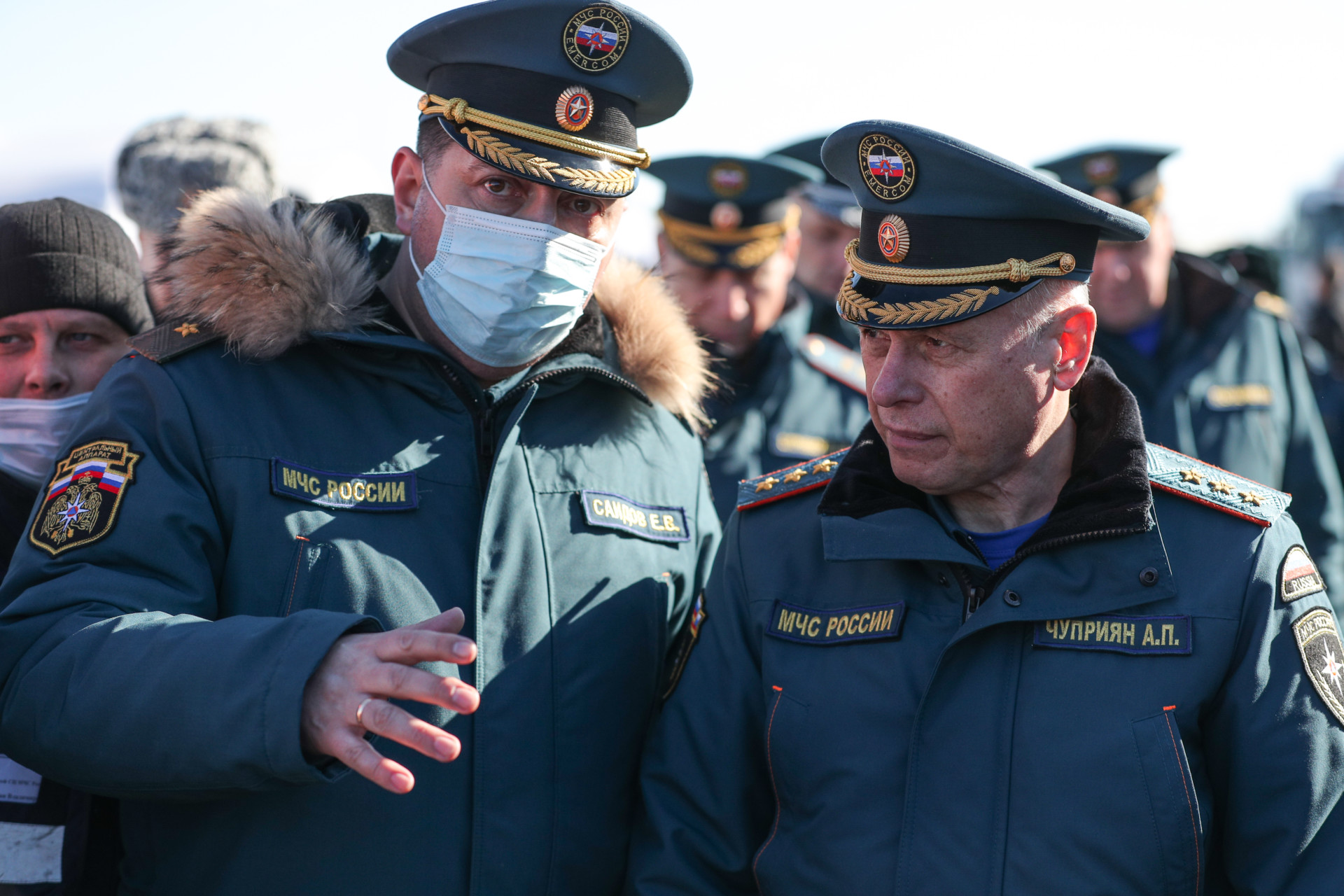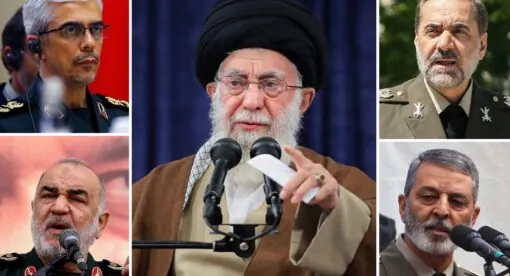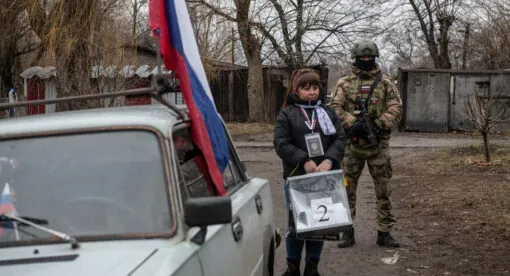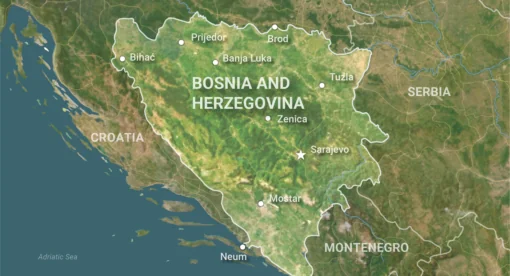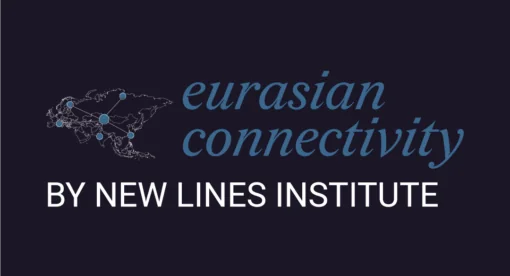Russia’s encirclement of Ukraine with more than 100,000 troops has led to a debate among the international community about Moscow’s goals. While much of this debate has focused on Ukraine’s potential ascension to NATO, the best framework for understanding Moscow’s behavior is the Kremlin’s perception that it is locked in a full-scale information war with the West. As Russian Defense Minister Sergei Shoigu said in a video published in January, “There is an information war on all fronts, and we have no right to lose this war.” This dynamic explains Moscow’s broader confrontation with the U.S. and Europe, its burgeoning relationship with China, and its goal in Ukraine: disrupting Ukrainian democracy.
Launching the Information War
Moscow’s perception is driven by the longstanding tradition among Russia’s political elite of projecting domestic instability onto international competition. That currently means Moscow’s political and security elites see democratic political movements inside Russia and around the world not as the logical consequence of repressive political systems but rather as the result of Western states using information warfare to promote liberal values. It was Western democracy promotion Putin was referring to when he said, “Cultural self-awareness, spiritual and moral values, and value codes are an area of fierce competition. Sometimes, it is subject to overt informational hostility … and well-orchestrated propaganda attacks.”
From Moscow’s perspective, Western governments use the manipulation of value codes – democracy promotion – to overthrow target regimes by creating color revolutions. The process of generating color revolutions is described by some members of Russia’s security services as “New Generation War” and plays a central role in Moscow’s threat perception vis-à-vis the West. As Valery Gerasimov, chief of the General Staff of the Russian Armed Forces, argued in 2014, “‘Color revolutions’ are becoming the main means of achieving (Western countries’) political ambitions.”
Moscow’s information worldview ignores individual agency and assumes that all democratic movements are created and controlled by Western states to achieve geopolitical goals, including overthrowing the Putin regime. This is the internal logic behind labeling any domestic political group that promotes liberal values, such as the movement of Russian democracy activist Alexei Navalny, as “foreign agents.” Russia’s political and military elite have come to see every democratic civil resistance movement, from the Arab Spring to the EuroMaidan protests in Ukraine, as being the intentional work of Western governments using their color revolution weapon. This belief explains why the Russian government felt it was under siege when pro-democracy demonstrations broke out inside Russia in 2011-2012. Putin blamed the protests on Western states broadly, and U.S. Secretary of State Hillary Clinton specifically, accusing the opposition of being funded by “so-called grants.”
While the Kremlin was still reeling from this perceived attempt to overthrow the Putin regime, the EuroMaidan protests began in Ukraine in 2013. The protest movement – which led Ukrainian President Viktor Yanukovych to flee the country and moved Ukraine toward Europe and away from Russia – was described by Putin as a fascist coup perpetrated by the West. In its aftermath, Putin said, “Our western partners have crossed the line.” In 2014, Gen. Nikolay Bordyuzha, then secretary-general of the Collective Security Treaty Organization, claimed that “essentially, a full-scale information war has been launched in the global information space.”
As retaliation for perceived Western aggression, the Kremlin launched an information war of its own. If the West was promoting liberal values and supporting liberal politicians in Russia, then Moscow would promote illiberal values and illiberal politicians across the West. If Western information warfare had launched the Arab Spring, Moscow would stomp out its last vestiges through military intervention in Syria. And if the West was using diplomacy to support democratic openings in countries such as Myanmar and Sudan, Moscow would exert counterpressure to support illiberal military governments.
As part of this conflict, Moscow has developed innovative new information tools by combining its traditional use of state media, overt and covert propaganda, and active measures alongside modern communications systems like social media. Since Moscow launched this war, the decline of global democracy has accelerated. Russia’s worldview is attractive to authoritarian leaders of all stripes – notably, the Chinese Communist Party. Chinese government officials have increasingly adopted Moscow’s belief that the U.S. is seeking to overthrow their government using color revolutions, further aligning Putin and Chinese Premier Xi Jinping. For example, the Chinese government labeled the 2021 protests in Hong Kong an “attempted Color Revolution backed by the U.S. and the West,” with Chinese State Councilor and Foreign Minister Wang Yi saying China would continue working with Russia to fight color revolutions and “disinformation.”
Ukraine’s Central Role
At their heart, information wars are a competition between narratives. The Kremlin’s core narrative, that democratic uprisings or color revolutions are Western coups that only lead to chaos, is in competition with what might be called a pro-democracy narrative or the “Western” narrative, which sees color revolutions as positive events in which individuals exercise their agency to establish greater political rights. Post-EuroMaidan Ukraine is ground zero for the confrontation between these two narratives.
Speaking in Ukraine in 2015, then-Vice President Joe Biden described the movement as providing an opportunity to “bend the arc of history of this nation toward greater justice and opportunity for the Ukrainian people.” Meanwhile, Putin’s Russia has continued to portray EuroMaidan as a fascist coup that unleashed chaos in Ukraine. For example, Russian state media has created fake news stories about Ukrainian Jews fleeing the country as a result of state-sponsored antisemitism, with the head of Russia’s Foreign Intelligence Service recently describing present-day Ukraine as being like taking a time machine back to the years of Nazi occupation. This portrayal of Ukraine has even led some Russians to believe they would be greeted as liberators in a military conflict.
Despite the stories coming out of Moscow, the areas of Ukraine that are not under active invasion by Russian or Russian-backed troops are stable. In contrast to the accusations of being a western puppet state, Ukraine held free, fair, and independent elections in 2019. Ukrainian President Volodymyr Zelensky won by promising to tackle corruption and create widespread prosperity. The early returns show signs of success, with Ukraine achieving a record high GDP in 2021.
The reality of an independent and stable Ukraine amounts to an irrevocable rebuttal of Moscow’s information worldview. Not only does the existence of a stable and independent Ukraine destroy its “fascist coup” narrative, but a successful post-EuroMaidan Ukraine will lead the Russian people to an inescapable conclusion: Color revolutions are good. To avoid losing the competition between narratives, the Kremlin is now seeking to manufacture the chaos it has argued always existed.
Recommendations
Moscow’s information war is organized around making democracy unappealing. At a time when the Kremlin is fighting against widespread domestic anti-corruption and pro-democracy protests, the Russian government sees a successful Ukrainian government as an existential threat. If soft power is the modern equivalent of “airstrikes and invasions of large armies,” as retired Russian Col. Gen. Leonid Ivashov once described it, then a prosperous and free Ukraine amounts to an information nuclear weapon aimed straight at Moscow. This is the weapon Putin is willing to risk devastating economic sanctions to neutralize.
To protect the Russian regime, Moscow’s goal in Ukraine is to destabilize its democratic government, and it is threatening military action to achieve this goal – a catastrophic possibility for ordinary Ukrainians. It is possible Moscow will take an iterative approach to destabilization by escalating its invasion of Eastern Ukraine, triggering economic collapse, or threatening military action to compel Kyiv to implement the Minsk agreements – an action that analysts argue would trigger a political crisis in the country. Whatever methodology the Kremlin decides on, it will not stop until it disarms the soft power threat of Ukrainian democracy.
Western countries should keep in mind that Moscow’s behavior in Ukraine is part of a protracted information confrontation where the political elite in Russia, and increasingly China, interpret the mere existence of democratic values as a domestic security threat. The struggle of the Ukrainian people to preserve their democracy is part of the same information war in which Moscow intervenes in Western elections to support illiberal leaders. In its negotiations with the West, Moscow is looking not only to create fissures between allies but also to generate contradictions between the West’s stated and practiced values. To successfully navigate the crisis, Western states should keep fidelity with their values by centering the agency of the Ukrainian people through their democratically elected leaders and follow the dictum voiced by U.S. Secretary of State Antony Blinken: “Nothing about Ukraine without Ukraine.”
Ben Sohl is a graduate of the Fletcher School of Law and Diplomacy at Tufts University, where he studied Russian information warfare. Ben previously worked at think tanks in Washington, D.C., and has published in Strategy Bridge, Inkstick Media, The National Interest, and with the Center for Strategic Studies at Tufts. He can be followed on Twitter at @Ben_Sohl.
The views expressed in this article are those of the author and not an official policy or position of the New Lines Institute.

